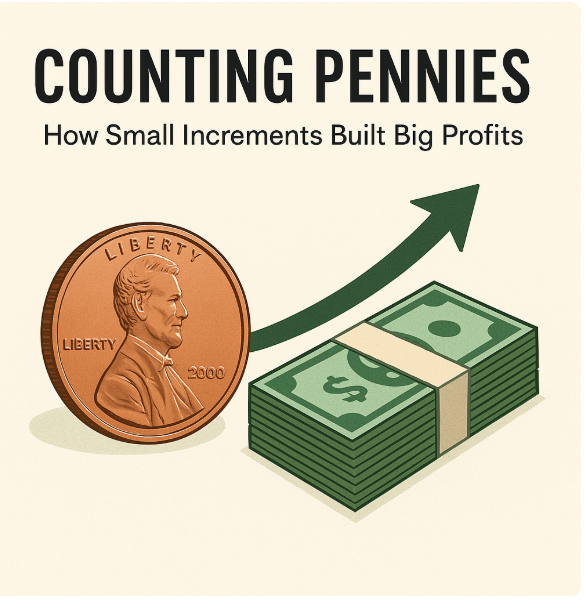Great fortunes are often built one penny at a time.
I learned that truth long before I ever ran a Fortune 500 company.
As a teenager, I washed dishes at a bakery where the owner insisted we reuse parchment paper on cookie trays. Each reuse saved just two cents. At first, it seemed trivial. But over hundreds of trays a day and thousands a week, those pennies compounded into meaningful savings.
That was my first lesson in profitability through small increments.
Pennies Add Up
In high school, I sold $2,000 worth of ten-cent raffle tickets to help rebuild a church. Spare change flowed easily when multiplied across hundreds of contributors.
At Harvard Law School, I raised $10,000 for dorm projects by charging a dollar for Saturday night movies and installing two pinball machines that devoured quarters for 16 hours a day.
By the time I became an operating executive at Pitney Bowes, I had internalized one simple principle:
The aggregation of small payments produces outsized returns.
Leases and Ancillary Fees
When I became President of Pitney Bowes Financial Services in 1993, that principle guided everything. With more than a million lessees, small fees at scale meant big profits.
-
Value-added fees customers welcomed. Our best example was ValueMax. Instead of requiring insurance certificates on leased equipment, we offered to replace lost, stolen, or damaged units for $10 per month. Customers gladly paid for the convenience. That one idea generated $30+ million annually.
-
Cost recovery fees. We added late fees, charged $40 for credit checks, and billed $15 for delivery or pickup. Customers accepted them because they covered real costs. Within a decade, fee revenue rose from $4 million to $230 million.
Turning Float Into a Bank
Our Postage-by-Phone system collected deposits from more than a million customers, holding them for an average of ten days. The float was valuable — until the Postal Service tried to seize it in 1995.
We fought back, won in court, and collected a $51.7 million settlement. But the bigger insight was forward-looking:
Why not use those deposits to fund credit for our customers?
To do that, we needed a bank charter. We formed the Pitney Bowes Bank in Utah. The results were transformative:
- $600 million in average daily deposits.
- Capital available at 1%.
- A highly profitable $200 million line-of-credit business.
All from pennies, multiplied at scale.
Supplies and Reload Fees
As postage meters shifted from mechanical to digital inkjet printers, many feared losing customers. I looked at consumables.
Ink cartridges became a durable revenue stream. Customers weren’t particularly price sensitive — much like home printer users today.
We also charged modest fees for phone and online meter reloads. For customers, the time saved was worth the pennies. For us, the aggregation drove millions.
Postage Discounts: Sharing the Savings
Two numbers obsessed me:
- 1.2 million postage meters under rental.
- $14 billion in postage flowing through them annually.
Since 1980, I believed metered mail deserved discounts because it saved the Postal Service real costs versus stamps. Even two cents per mailpiece equaled $350 million in potential value.
For years the Postal Service resisted. But persistence paid off. Eventually, metered and Internet postage both earned a one-cent discount per piece.
When your product creates measurable savings, fight to share in those savings.
The Mailstream and Presort
In 1996, as CEO, I set a bold goal: Pitney Bowes should participate in the processing of every piece of mail worldwide. At the time, over 200 billion pieces were sent annually.
We coined the term mailstream — broadening our scope beyond postage meters. This reduced antitrust risk and expanded our opportunities.
The breakthrough came in presort services. By acquiring PSI Group in 2002 and expanding nationwide, we built:
- A $500 million business.
- 15+ billion pieces handled annually.
- 20% operating margins.
Every 0.1% increase in postal discount spreads delivered $15 million in profit.
The Overarching Lesson
From bakery parchment to presort mail, from pinball machines to banking float, the pattern is unmistakable:
Small increments, multiplied by scale, drive extraordinary profitability.
Executives often chase breakthroughs or massive cost cuts. But the most reliable gains often come from overlooked micro-transactions.
Customers gladly pay pennies for convenience. Partners will share savings when costs are reduced. And what looks trivial in isolation becomes a profit engine when scaled across millions of customers and billions of transactions.
When I became CEO, my ambition wasn’t to bet the company on moonshots. It was to find, protect, and expand those pennies.
Because pennies, multiplied relentlessly, become the difference between mediocrity and market leadership. ✅

